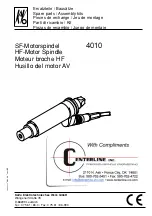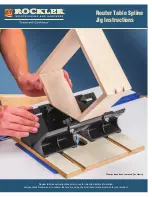
26
| English
1 609 929 N94 | (3.9.08)
Bosch Power Tools
When routing with the parallel guide
26
, the
dust/chip extraction should take place via the
special extraction adapter for the parallel guide
32
. The extraction adapter
24
can remain
mounted.
Routing with the Router Compass
(see figure F)
The router compass/guide-rail adapter
33
can
be used for circular routing jobs. Mount the
router compass as shown in the figure.
Screw the centring screw
38
into the thread on
the router compass. Insert the point of the cen-
tring screw into the centre of the circular arc to
be routed, paying attention that point of the
screw engages into the workpiece surface.
Coarsely adjust the required radius by moving
the router compass and tighten the wing bolts
35
and
36
.
The length can be fine adjusted with the fine-ad-
justment knob
37
after loosening the wing bolt
36
. One revolution corresponds with a setting
range of 2.0 mm. One graduation mark on the
fine-adjustment knob
37
changes the setting
range by 0.1 mm.
Guide the switched on power tool over the
workpiece with the right handle
1
and the router
compass handle
34
.
Routing with Guide Rail (see figure G)
Straight routing cuts can be carried out with
help of the guide rail
40
.
The base spacer
39
must be mounted in order to
compensate the height difference.
Mount the router compass/guide-rail adapter
33
as shown in the figure.
Fasten the guide rail
40
to the workpiece with
suitable clamping devices, e. g. screw clamps.
Place the machine with the guide-rail adapter
33
mounted onto the guide rail.
Routing with Guide Bushing (see figures H–L)
The guide bushing
44
enables template and pat-
tern routing on workpieces.
In order to use the guide bushing
44
, the guide
bushing adapter
41
must be inserted into the
guide plate
12
first.
Place the guide bushing adapter
41
from above
onto the guide plate
12
and tighten it firmly with
the 2 fastening screws
42
. Pay attention that
the release lever for the guide bushing adapter
43
is freely movable.
Choose a suitable guide bushing, depending on
the thickness of the template or the pattern. Be-
cause of the projecting height of the guide bush-
ing, the template must have a minimum thick-
ness of 8 mm.
Actuate the release lever
43
and insert the guide
bushing
44
from below into the guide bushing
adapter
41
. Ensure that the encoding keys clear-
ly engage in the grooves of the guide bushing.
f
Select a router bit with a diameter smaller
than the interior diameter of the guide
bushing.
To ensure that the distance from router bit cen-
tre and guide bushing edge is uniform, the guide
bushing and the guide plate can be adjusted to
each other, if required.
– Push the release lever
16
down and guide the
router to the stop in the direction of the base
plate
14
. Let go of the release lever
16
again,
in order to lock this plunging depth.
– Loosen the fastening screws
45
by approx.
2 – 3 turns so that the guide plate
12
can be
moved freely.
– Insert the centring pin
46
into the tool holder
as shown in the figure. Hand-tighten the
tightening nut so that the centring pin can
still be moved freely.
– Align the centring pin
46
and the guide bush-
ing
44
to each other by slightly moving the
guide plate
12
.
– Tighten the fastening screws
45
.
– Remove the centring pin
46
from the tool
holder.
– Push the release lever
16
and guide the
plunge router to the uppermost position.
For routing with the guide bushing
44
proceed
as follows:
– Guide the switched on power tool with the
guide bushing toward the template.
OBJ_BUCH-622-002.book Page 26 Wednesday, September 3, 2008 11:45 AM
















































